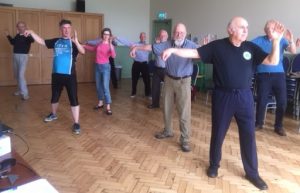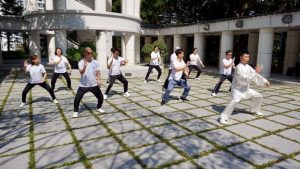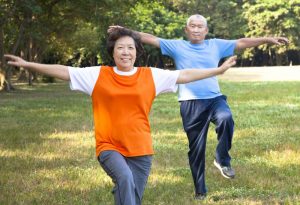Improve Hypertension with Yoga
By John M. de Castro, Ph.D.
“Yoga can reduce stress-induced hypertension, while addressing its underlying causes. It pacifies the sympathetic nervous system and slows down the heart, while teaching the muscles and mind to relax deeply.” – Marla Apt
High Blood Pressure (Hypertension) is an insidious disease because there are no overt symptoms. The individual feels fine. But it can be deadly as more than 360,000 American deaths, roughly 1,000 deaths each day, had high blood pressure as a primary or contributing cause. In addition, hypertension markedly increases the risk heart attack, stroke, heart failure, and kidney disease. It is also a very common disorder with about 70 million American adults (29%) having high blood pressure and only about half (52%) of people with high blood pressure have their condition under control. Treatment frequently includes antihypertensive drugs. But these medications often have adverse side effects. So, patients feel lousy when taking the drugs, but fine when they’re not. So, compliance is a major issue with many patients not taking the drugs regularly or stopping entirely.
Obviously, there is a need for alternative to drug treatments for hypertension. Mindfulness practices have been shown to aid in controlling hypertension. Exercise is also known to help. So, yoga practice, which combines mindfulness practice with exercise would seem to be a good candidate practice for the treatment of hypertension. Indeed, yoga practice appears to lower blood pressure in hypertension.
In today’s Research News article “Effects of a health worker-led 3-month yoga intervention on blood pressure of hypertensive patients: a randomised controlled multicentre trial in the primary care setting.” (See summary below or view the full text of the study at: https://www.ncbi.nlm.nih.gov/pmc/articles/PMC7981931/ ) Dhungana and colleagues recruited adults with hypertension who didn’t practice yoga and randomly assigned them to a wait-list control condition or to receive 5 2-hour yoga training sessions and 1 health education session followed by 90 days of home practice for 30 minutes per day for 5 days per week. They were measured before and after training for systolic and diastolic blood pressure, heart rate, and body size.
They found that in comparison to baseline and the wait-list control group, the patients with hypertension who practiced yoga had significant reductions in both systolic (8%) and diastolic (7%) blood pressure. These results are similar to those found in other studies that yoga practice lowers blood pressure in patients with hypertension. The contribution of the present study is to demonstrate that after training, yoga practice at home is a safe and effective treatment for hypertension.
So, Improve Hypertension with Yoga.
“Adults who practice yoga with breathing and relaxation exercises at least three times a week may have lower blood pressure than people who don’t.” – Lisa Rapaport
CMCS – Center for Mindfulness and Contemplative Studies
This and other Contemplative Studies posts are also available on Google+ https://plus.google.com/106784388191201299496/posts and on Twitter @MindfulResearch
Study Summary
Dhungana, R. R., Pedisic, Z., Joshi, S., Khanal, M. K., Kalauni, O. P., Shakya, A., Bhurtel, V., Panthi, S., Ramesh Kumar, K. C., Ghimire, B., Pandey, A. R., Bista, B., Khatiwoda, S. R., McLachlan, C. S., Neupane, D., & de Courten, M. (2021). Effects of a health worker-led 3-month yoga intervention on blood pressure of hypertensive patients: a randomised controlled multicentre trial in the primary care setting. BMC public health, 21(1), 550. https://doi.org/10.1186/s12889-021-10528-y
Abstract
Background
Hypertension control remains a major challenge globally. A recent systematic review suggested that yoga has beneficial effects on reducing blood pressure. However, the role of yoga in hypertension management in primary health care has received little attention, and no studies have evaluated the impact of a yoga program fully delivered by health care staff on hypertension. This study, therefore, assessed the effects of a health worker-led yoga intervention on blood pressure reduction among hypertensives patients in the primary care setting.
Methods
This was a multicentric, two-arm, randomised trial conducted among hypertensive patients in seven Ayurveda Health Centres in Nepal between March 2017 and June 2018. One hundred and twenty-one participants who were on or without medications were randomised to intervention (n = 61) and wait-list control (n = 60) groups using stratified block randomisation. Participants in the intervention arm received an intervention consisting of an initial five-day structured yoga training at the centres and then a further home-based practice of yoga for five days a week for the following 90 days. Both intervention and control groups also participated in a 2-h health education session. The primary outcome of this trial was systolic blood pressure at 90-day follow-up. Data were analysed on an intention-to-treat basis using linear mixed-effects regression models.
Results
We included all 121 study participants (intervention/control = 61/60) in the primary analysis (52.1% males; mean ± SD age = 47.8 ± 10.8 years). The difference in systolic blood pressure between the intervention group and the control group was − 7.66 mmHg (95% CI: − 10.4, − 4.93). For diastolic blood pressure, the difference was − 3.86 mmHg (95% CI: − 6.65, − 1.06). No adverse events were reported by the participants.
Conclusions
A yoga program for hypertensive patients consisting of a five-day training in health centres and 90 days of practice at home is effective for reducing blood pressure. Significant benefits for hypertensive patients could be expected if such programmes would become a part of the standard treatment practice.
https://www.ncbi.nlm.nih.gov/pmc/articles/PMC7981931/









